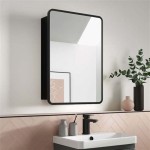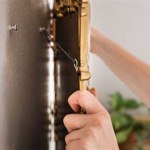Hanging a Mirror on Drywall
Hanging a mirror on drywall requires careful planning and execution to ensure both the mirror's safety and the wall's integrity. Several factors influence the best hanging method, including the mirror's size, weight, and the wall's location and construction.
Assessing the Mirror and Wall
Before beginning, carefully examine the mirror's backing for existing hardware. Some mirrors have D-rings, wire, or keyhole slots pre-installed. Note the mirror's dimensions and weight as these factors dictate the type of hanging hardware required. Next, inspect the wall. Locate studs using a stud finder for optimal support, especially for heavier mirrors. Mark the stud locations with a pencil. Consider the wall's location; areas with high humidity, like bathrooms, may necessitate specialized hardware to prevent corrosion.
Choosing the Right Hanging Hardware
The weight and size of the mirror determine the appropriate hanging hardware. For lighter mirrors, adhesive hooks or small nails might suffice. However, heavier mirrors require more robust solutions such as heavy-duty picture hangers, mirror clips, or French cleats. French cleats offer exceptional stability for large, heavy mirrors as they distribute the weight across a larger surface area. When selecting hardware, always choose options rated to support a weight exceeding the mirror's actual weight for an added safety margin.
Utilizing Wall Anchors for Added Security
When hanging into drywall without hitting a stud, wall anchors are essential for providing secure support. Several types of anchors are available, each suited to different weights and applications. Plastic expansion anchors are suitable for lightweight mirrors, while molly bolts or toggle bolts offer greater holding power for heavier items. Always follow the manufacturer's instructions for proper anchor installation to ensure optimal performance.
Marking and Positioning the Mirror
Accurate measurements are crucial for achieving a level and centered mirror placement. Determine the desired height for the mirror's center point and mark it on the wall. Using a level, extend a horizontal line across the wall at this mark. If using D-rings or wire, measure the distance between them and transfer these measurements to the horizontal line on the wall. This ensures the hanging hardware will align correctly with the mirror's hanging points.
Installing the Hanging Hardware on the Wall
With the markings in place, install the chosen hanging hardware on the wall. If using anchors, pre-drill the appropriately sized pilot holes before inserting the anchors. Securely fasten the hooks, clips, or cleat components to the wall, ensuring they are flush and level. Double-check the positioning of the hardware against the markings to ensure accuracy before proceeding to hang the mirror.
Hanging the Mirror Securely
Carefully lift the mirror and align the hanging hardware on the back with the corresponding hardware on the wall. Gently lower the mirror onto the hardware, ensuring it sits securely. For heavier mirrors, having assistance during this step is recommended to prevent accidents and ensure proper placement. Once the mirror is hanging, use a level to verify its alignment and make any necessary adjustments.
Adding Safety Considerations
For added safety, especially in earthquake-prone areas or households with children, consider securing the mirror to the wall with additional safety hardware. Mirror straps or adhesive safety bumpers can prevent the mirror from falling in the event of an accident or seismic activity. These simple precautions offer peace of mind and protect against potential damage and injury.
Dealing with Irregularly Shaped Mirrors
Hanging irregularly shaped mirrors presents unique challenges. For these mirrors, carefully trace the outline of the mirror onto a piece of paper to create a template. Mark the location of any existing hanging hardware on the template. Position the template against the wall and use a level to ensure it is straight. Transfer the markings for the hanging hardware onto the wall using the template as a guide. This technique provides accurate positioning for secure installation.
Addressing Bathroom Considerations
Bathrooms present unique challenges for hanging mirrors due to moisture and humidity. Ensure the chosen hardware is corrosion-resistant. Consider using specialized mirror mastic, an adhesive designed for humid environments, in conjunction with mechanical fasteners for added security. Adequate ventilation in the bathroom also helps to prevent moisture buildup and protect the mirror and its backing.

How To Hang A Heavy Mirror On Drywall Stas Picture Hanging Systems
How To Hang A 100 Pound Mirror On Drywall Quora

How To Hang A Mirror On Drywall

How To Hang A Large Or Heavy Mirror

How To Hang A Heavy Mirror With French Cleat

How To Hang A Heavy Mirror The Home Depot

A Better Way To Hang Heavy Mirror Hanging Brackets

How To Hang A Heavy Mirror In 5 Simple Steps

How To Hang A Heavy Mirror

How To Hang A Heavy Mirror On Drywall Stas Picture Hanging Systems








